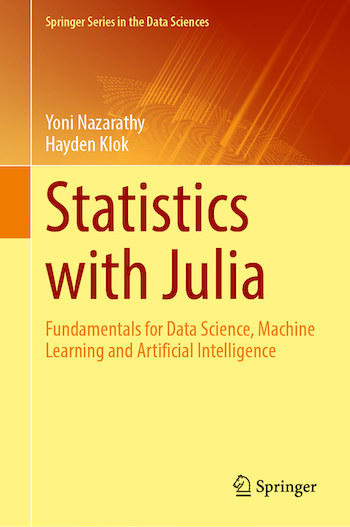Statistics with Julia:
Fundamentals for Data Science, Machine Learning
and Artificial Intelligence.
A book by Yoni Nazarathy and Hayden Klok.
If you are affiliated with a University, in certain cases you may try to access the book directly via SpringerLink. You may also try to purchase the book from Springer, or some vendor such as Amazon. Note that as authors we have no control over the price that Springer charges for the book.

This website contains some additional resources related to the book. The gallery page presents all of the Julia generated plots within the book with direct links to the source code. The tutorials page links to videos related to the book or to statistics with julia in general. Importantly, the book's Julia source code has become a popular resource for those exploring Julia and data science and you are welcomed to use this source code with the book or independently.
About the book: Statistics with Julia is your one stop shop for statistics, machine learning, and data science using the Julia language. Use the book if you are a Julia user who wants to learn statistics or improve your statistics knowledge. Use it if you know some statistics and want to explore how it is done via Julia. Use it if you are just entering the world of data science and want to pick up a cool modern programming language together with the study of elementary statistical concepts needed for machine learning, data science, and artificial intelligence. You can read it cover to cover, or access bits in random order. Most importantly you may try out the Julia source code as you read the book.
See what co-creators of the Julia language are saying about the book:
Professor Alan Edelman, MIT: With “Statistics with Julia”, Yoni and Hayden have written an easy to read, well organized, modern introduction to statistics. The code may be looked at, and understood on the static pages of a book, or even better, when running live on a computer. Everything you need is here in one nicely written self-contained reference.
Dr. Viral Shah, CEO of Julia Computing: Yoni and Hayden provide a modern way to learn statistics with the Julia programming language. This book has been perfected through iteration over several semesters in the classroom. It prepares the reader with two complementary skills - statistical reasoning with hands on experience and working with large datasets through training in Julia.